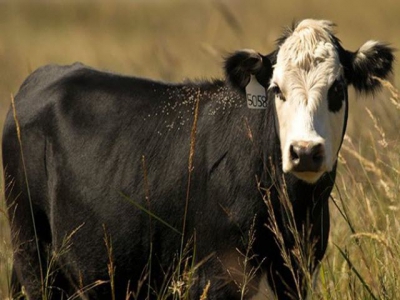Crossbreeding may improve beef cattle efficiency in grazing systems

Planned crossbreeding systems using breeds that complement one another can reduce cost of maintaining cow/calf herd.
An Oklahoma State University study showed the black baldy cows averaged a better body condition score than the straight Angus cows.
Animal scientists with Oklahoma State University’s Division of Agricultural Sciences & Natural Resources (DASNR) have long been paying attention to factors that affect cattle efficiency, and this past year, they decided to take a closer look at total calories a cow consumes relative to her calf’s weaning weight.
“In this experiment, we set out to determine if we could potentially reduce annual cow maintenance costs with Hereford-sired black baldy cows compared to straight-bred Angus cows,” said Dave Lalman, Oklahoma Cooperative Extension Service beef cattle specialist with the DASNR department of animal and food sciences.
“While there is substantial older data available on the question of heterosis, there is not much data available on the influence of crossing a breed known for lower feed intake — the Hereford breed — with the popular Angus breed,” he said.
DASNR pointed out that considerable research exists to indicate that a simple crossbreeding system can result in improved cow longevity and fertility compared to a purebred or straight-bred system. In fact, DASNR said years of crossbreeding studies conducted at the U.S. Department of Agriculture's U.S. Meat Animal Research Center showed an average improvement in weaning weight per cow when a simple two-breed rotation was used with bos Taurus breeds such as Hereford and Angus. This advantage is known as heterosis, or hybrid vigor.
Another potential benefit of crossbreeding, and one often overlooked, is to select the second breed in the crossbreeding system based on inherent characteristics that might reduce costs or improve income in the operation. The idea of selecting breeds that “complement” one another in this way is known as “breed complementarity” in the animal breeding world.
The Oklahoma State researchers broke the study into two phases: maintenance energy requirements, and voluntary feed intake. How well do black baldy cows retain body condition compared to Angus cows? What is the forage intake difference between the black baldy cows and the straight Angus cows?
“As cattle producers know, cow/calf operations need to have pregnant cows that are able to maintain a good body condition through the relatively harsher winter months while also providing needed nutrients to the as-yet-unborn calf inside them,” Lalman said. “If the cows can do that while consuming fewer nutrients, the reduction in input costs provides an advantage in annual cow costs.”
The Oklahoma State study showed that the black baldy cows averaged a better body condition score than the straight Angus cows. In fact, the crossbred cows maintained better body condition throughout both phases of the experiment, DASNR said.
“On average, we measured just under 2 lb. per day less moderate-quality forage intake in the crossbred cows,” Lalman said. “On an annual basis, the black baldy cows would be expected to consume about 725 lb. less forage.”
That has led to an interesting consideration for cow/calf producers: Some of the more productive native range in Oklahoma produces about 3,000 lb. of forage per acre. However, studies by rangeland ecologists have led to recommendations that cattle producers should aim for livestock to consume only about 25% of available forage per acre — and 25% of 3,000 lb. is 750 lb.
“By using the crossbred female and taking advantage of lower feed intake and maintenance requirements of Hereford cattle in our crossbreeding system, we should be able to increase stocking rate or reduce the number of acres required by about one acre per cow/calf unit,” Lalman said.
He emphasized that this is not to imply that raising purebred animals is a bad thing, because there are many reasons to do so. However, simple, planned crossbreeding systems using breeds that complement one another can reduce the cost of maintaining a cow herd and increase ranch output through improved longevity and fertility.
“Raising livestock is not, nor has it ever been, a one-size-fits-all solution,” Lalman said. “Cow efficiency is one more important feature in the cattle producer’s toolbox relative to the decision-making process.”
Related news
 Effective parasite control begins with understanding active ingredients
Effective parasite control begins with understanding active ingredients Strategic use of active ingredients offers promise in managing parasites.
 Supercomputers help target bovine TB
Supercomputers help target bovine TB Researchers will use supercomputers to predict bovine TB status of dairy cows.
 Adding fat to pregnant cow diets may boost yield, performance
Adding fat to pregnant cow diets may boost yield, performance Supplementing feed with fatty acids for pregnant dairy cows may improve milk yield and reproductive performance, say researchers.